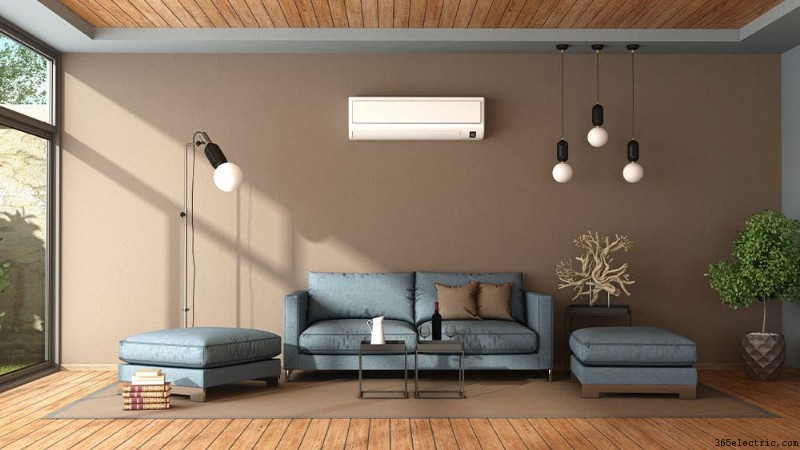Mini-Split vs központi légkondicionáló:melyik típus a legalkalmasabb az Ön otthonába?

A motiváció egy új légkondicionáló rendszer otthonában való telepítése mögött emberekről emberekre változik; egyre melegebb van, és a régi AC már nem végzi el a munkát. Vagy esetleg azt tervezi, hogy extra klímaberendezést épít be otthonába, esetleg felújít vagy épít egy házat, és a legjobb hűtőrendszert keresi. Ezekben az esetekben a legjobb két lehetőség a mini split vs. central air.
Az Egyesült Államokban az otthonok túlnyomó többsége központi légkondicionáló rendszert használ. Ennek ellenére a mini-splitek is egyre népszerűbbek, mivel könnyen telepíthetők, és rugalmasak nyáron és télen egyaránt.
A mini split és a központi légkondicionáló összehasonlításakor vegye figyelembe az egység költségét, a ház méretét, az esztétikai preferenciákat, az energiahatékonyságot és az üzemeltetési költségeket, hogy megtalálja otthona számára a legjobb rendszert.
Ez a cikk mindent megtud, amit tudnia kell, hogy megalapozott döntést hozzon, amikor klímaberendezést választ otthonába:
- Hogyan működnek a mini split és központi légkondicionálók?
- A mini split rendszerek előnyei és hátrányai
- A központi légkondicionáló előnyei és hátrányai
- Hogyan lehet intelligenssé tenni a mini split és központi légkondicionálókat?
- Döntse el, hogy a mini split vagy a központi AC a legjobb az Ön igényeinek?
Hogyan működnek a mini-split és központi légkondicionálók?
Mind a központi, mind a légcsatorna nélküli klímaberendezések ugyanazt a tudományt használják. A meleg levegőt beszívják, a hőt kiengedik a szabadba, és a most lehűlt levegőt szétterítik a beltérben, így biztosítva a hűvös és nyugodt környezetet. Nézzük meg, hogyan működik mindkét légkondicionáló berendezés.
Mini felosztások működése
A mini split okos választás otthonokba és korlátozott helyekkel rendelkező területekre. Hasonlóak az ablakos AC egységhez, mivel egyetlen helyiség hűtésére szolgálnak. Az ablakos klímaberendezésekkel ellentétben azonban külön kültéri egységgel rendelkeznek.
A mini-spliteket az különbözteti meg a központi klímaberendezésektől, hogy nincs szükség csatornákra. A légcsatorna nélküli mini-split hőszivattyús rendszer kényelmes megoldást jelenthet olyan otthonokban, ahol nincsenek csatornák, vagy további helyiségek, például garázs vagy fészer hűtésére szolgál.
A mini-split rendszerben a beltéri egység egy ventilátorból és egy párologtatóból áll, amely meleg levegőt szív be a helyiségből, és hideg levegőt fúj. A központi hűtőrendszerrel ellentétben a hideg levegő közvetlenül abba a helyiségbe kerül vissza, ahol a beltéri egység fel van szerelve. Ez kiküszöböli a csatornákkal kapcsolatos energiaveszteségeket. Ezután jön a kültéri egység, amely egy kondenzátor, és fogadja a hőt az Ön otthonából, és kiengedi azt kifelé.
A központi légkondicionálók működése
A központi légkondicionáló egység egy légcsatornás rendszer, amely egy sor csatornát és szellőzőnyílást használ a hideg/meleg levegő keringetésére otthonában. Kondenzátorból, kompresszorból és légkezelő egységből áll.
A visszatérő szellőzőnyílások először szívják ki a meleg levegőt a házból, és küldjék a légkezelőbe, hogy szűrjék és hűtsék. The condenser, which is the outdoor unit, provides refrigerant, a cooling substance, to the indoor handler’s evaporator coils. As the warm air from your house blows over the evaporator coils, it cools down and is delivered using ducts and supply vents.
If your house already has a duct system, it is a perfect fit for central air conditioning, although it’s also possible to add a central system to a home that is not already equipped.
Pros &Cons of Mini-Split Air Conditioners

From improved energy efficiency to less operating costs, mini-split provides several advantages to homeowners; however, some downsides also need to be taken into account.
| Pros of Mini-Split | Cons of Mini-Split |
| Ease of installation | Their indoor unit looks unappealing |
| More energy efficient | The initial purchase is costly |
| You can control the temperature of individual rooms | Not always suitable for larger areas |
| Fewer costs over time | Poor ventilation |
| They produce minimal noise | |
| Best for small disconnected rooms | |
| More design options are available |
Pros of Mini-Split Air Conditioner
Here are the main advantages of a mini-split system:
Ease of Installation
The mini-split installation is a breeze as it requires only mounting a wall unit, and there are no lengthy ducts involved. It also takes less time, depending on the number of units to be installed. They can be up and running in less than a day. To connect the indoor unit with the outdoor unit, the connecting pipe just requires a three-inch hole to be drilled in the wall. You don’t have to worry about rebuilding walls or ceilings around the ducts.
More Energy Efficient
Mini-splits are considered energy efficient as they have no ducts that can contribute to energy loss. The loss associated with ducts can account for 30% of energy consumption, and this can further increase if there are holes, gaps, and cracks in the ductwork.
Mini-splits cool/heat with high precision as they deliver air straight from the unit to the focused area. This increases its efficiency and reduces the electricity cost.
Control Temperature of Individual Rooms
Installing a mini-split in each room of your house ensures that you can individually control the temperature of each room. Multi-split units offer you the flexibility to cool/heat various rooms with just one outdoor unit. You can install different indoor units in separate rooms connected with one outdoor unit. This allows you to have a different temperature setting for each room using an AC remote control or a mini-stat.
If your basement area is a little chilly in spring, you can just turn the heat on there without overheating your other rooms. If your attic area heats up fast during summer mornings, you can turn on your mini-split without disturbing other rooms. Convenient, right? These are just two examples; you can have them installed in every room of your home and operate only when required.
Moreover, you save on energy and bills as you are only using the individual units when required instead of turning them all on at once.
Fewer Costs Over Time
The initial cost associated with a mini-split is high compared to a central AC of the same capacity, but don’t let that deter you from investing in a ductless system. As mentioned above, it is more energy-efficient than a central AC, which means it helps you save on bills in the longer run. Moreover, mini-splits won’t be as heavy on your wallet as central units when it’s time for maintenance.
They Produce Minimal Noise
Mini-splits produce considerably less noise than a ducted system. Ducts create more noise due to vibrations they experience when delivering air to the house. This issue is non-existent in a ductless mini-split system.
Further, the fans of modern ductless systems run at a low speed, producing minimal noise and providing you a comfortable environment. If though there is an issue with your mini-split, you might end up hearing strange noises from your AC which can indicate a problem.
Best for Small Disconnected Rooms
If you already have a central system and want to install air conditioners in areas disconnected from the ductwork in the rest of your home, a mini-split system can be the solution. You can install it in a garage, a mini work-shed, or anywhere where the ducts can’t be reached.
More Design Options Are Available
With mini-splits, you can choose from various types available according to your decor or requirement.
- You can choose a concealed mini-split or ceiling cassette mini-split if you do not want a large indoor unit displayed on your wall. They are mounted on the ceilings and don’t clash with the overall aesthetics of your room.
- A floor-mounted mini-split is suitable for rooms with low ceilings or slanted walls. If you want to install an air conditioner in an attic, this one is a convenient option.
- If you have straight high ceilings, just go with the usual wall-mounted option. It is an inexpensive selection and is suitable for rooms with 7- to 8-inch-high ceilings.
Cons of Mini-Split Air Conditioners
To make the best mini-split vs. central air choice, you must consider some typical downsides of mini-split systems:
Mini-Split Units Can Look Unappealing
A large wall-mounted mini-split in your room can seem obtrusive and may affect the design of your room. The condensate pipe hanging near the outdoor unit can also seem quite unpleasant.
If the look of the indoor unit bothers you, opt for other options like a concealed mini-split unit.
The Initial Purchase Is Costly
The main disadvantage associated with the mini-splits is their initial cost. The average cost is $1,500 to $2,000 per 12000 BTU. This is 30% more when compared to the central air conditioners. This percentage doesn’t include the cost of purchasing and installing ducts which can be high.
The cost gets even higher if you have a large house and want to put separate units in every room.
Not Suitable for Larger Areas
Mini-split systems are not made for larger areas. They have limited cooling capability and are more suitable for cooling smaller places and individual rooms. For a very large room, multiple units can be placed.
Poor Ventilation
Mini-splits do not bring fresh air from the outdoor; instead, they condition the already present air inside your room. Since you close doors and windows when running air conditioning, many airborne particles, dust, and bacteria can freely float in the air. To tackle the issue, you may need to look into air purification.
Pros &Cons of a Central Air Conditioner

There are pros and cons to employing a central air conditioner to cool your home that needs to be assessed before purchasing.
| Pros of Central Air Conditioner | Cons of Central Air Conditioner |
| They are ideal for larger homes | Need for extensive ductwork |
| Clean, ventilated air circulates across your home | Ductwork requires high maintenance |
| They don’t disrupt the aesthetics of your home | High operating costs |
| Lower initial costs |
Pros of Central Air Conditioners
Some of the key advantages commonly associated with a central air conditioner are:
They Are Ideal for Larger Homes
Unlike mini-splits, central air conditioners are made to meet the demands of larger homes. These units are great for keeping larger areas cool and comfortable, even during the hottest months of the year.
Clean, Ventilated Air Circulates Your Home
A central air conditioner not only regulates temperature and humidity but it can also help with home ventilation. A central ducted air conditioner uses vents to ensure proper air circulation in your home. Return vents suck the unfiltered air from your home. That air is then filtered, and allergens are removed. The supply vents then supply the clean air to your home. This helps in improving air quality which means fewer pollutants exist in your home.
They Don’t Disrupt the Aesthetics of Your Home
A central AC’s indoor unit is usually out of sight, hidden in the basement or a garage. Hot/cool air is distributed through vents in each room, but they are unnoticeable and do not disrupt your home’s interior. The outdoor unit can be unsightly in your backyard, but you can always creatively hide it.
Lower Initial Cost
Cost is one major factor when comparing mini-split vs. central air systems. The upfront cost of central air is 30% less than mini-split systems minus the ductwork installation. If you already have ductwork in your home, then it is an affordable heating/cooling option.
Cons of Central Air Conditioning
Some of the key disadvantages to consider before making a final decision:
Need for Extensive Ductwork
If you already have ductwork in your home, installing a central air conditioner should not be a problem. However, if you are going to install ductwork for the first time, it will be a significant renovation process for your home that requires opening up walls. It will also be quite costly, so keep that in mind before opting for that option. Further, retrofitting a home to accommodate ductwork can be very expensive.
Ductwork Requires High Maintenance
The lengthy ductwork of the central air conditioner requires frequent maintenance, which can be a nuisance. You have to pay for sealing leaks, cleaning ductwork, and adding insulation. Ignoring routine tune-ups can also lead to costly repairs.
High Operating Costs
Air travels through extensive ductwork before it finally reaches your home. Energy loss associated with ductwork accounts for high energy consumption, increasing electricity bills. The loss can increase if ducts are not adequately insulated.
Moreover, a central air conditioner evenly heats/cools down your entire home, but it can be a disadvantage if you are not using all the rooms at once. Using a central air conditioner when you just want to cool/heat one or two rooms can lead to a dramatic increase in your bills. You can consider HVAC zoning to make the most out of this situation and keep your bills low.
How to Make Mini-Split &Central Air Conditioners Smart?

If you want automated cooling or heating in your simple mini-splits, all you have to do is buy smart AC controllers such as Cielo Breez Eco or Cielo Breez Plus. To make your central air conditioner smart, you have the option of installing smart thermostats.
These devices can make your dumb air conditioners smart. By connecting the devices with your AC, you would be able to utilize intelligent features such as setting up schedules according to the weather forecast, geofencing, getting usage reports, and so much more. With automation, you also save on electricity costs. You can manage all your AC settings using your smartphone from anywhere in the world. How cool is that?!
Mini-Split vs. Central Air Conditioner:How to Decide Which One Is Best for You?
When choosing between mini-split vs. central air, the best type for you depends on various factors that need to be weighed before coming to a conclusion. Here are some considerations you much acknowledge:
1. Do Your Cooling or Heating Needs Vary?
Does this happen that certain members of your family prefer very cold temperatures, while others would like to keep the temperature a few notches higher? Do you have many rooms in your house or sections which require varied cooling temperatures?
With a mini-split AC, you can install various indoor units and control each room’s temperature separately, very easily.
As far as central air conditioners are concerned, you can create zones to have different temperatures in the same house. You will have to install dampers in your system to create zones. But dampers are installed inside your ductwork, which means that you have to open up your wall or ceiling to install them, which is a lot of work.
If you are looking for an easy, non-invasive solution for your house, go for mini-split systems.
2. What Is the Size of Your Home?
Mini-splits are not always great for very large houses, but they are up to the task! Consider that the more rooms you have, the more units you will need, increasing your costs. But if you need to only cool these rooms on certain days and times, mini-splits can be a good option. If they require even cooling, then you can consider central air conditioning for your large home.
For a mini-split to work effectively, it needs to be installed in an area that is a perfect size for it. Our guide on air conditioner sizing will help you learn more.
3. Do You Require Heating in Addition to Cooling?
If you require cooling/heating packed in one unit, mini-split heat pumps are the solution. They operate the same way in winters; all you need to do is switch on the heat mode. If you have any confusion about running a ductless system in winters, read this article to learn more.
If you live in an area that gets extremely cold in winters and requires robust heating, heat pumps will not be able to provide adequate heating.
You can heat your house using a central AC, but you would require a separate furnace for that, which can be costly.
4. Would Noise Be an Issue for You?
With central air conditioners, you will hear loud noise reverberating through the ductwork when the unit is turned on. Ducts produce noises due to vibrations when air passes through them.
Mini-split does not have ducts, so the noise associated with them is eliminated. Modern mini-splits tend to be much quieter, so if you think noise can be an issue for you, consider choosing this type of air conditioner.
5. Can An Indoor Unit Affect Your Interior Decor?
Mini-splits have large indoor units that can be unattractive for some people. On the other hand, central air conditioners are mostly hidden from the inside of your home; they only have vents that can go unnoticed. They have outdoor units, just like the mini-splits that you can camouflage using different techniques.
If you can’t bear the look of mini-splits inside your room, consider leaning toward the central AC.
6. Energy Efficiency
In an HVAC world, efficiency is determined by EER/SEER rating systems. The higher the rating, the more efficient the unit.
The modern central ACs with a SEER 13 rating are considered standard efficiency units. The average SEER rating is between 15 and 18. The maximum efficiency rating is in mid 20s.
Of all the air conditioner types, mini-splits offer the highest SEER rating. The most efficient models have a SEER rating in 30s.
So, if you are looking for a unit that will consume less energy and does not burn a hole in your pocket with hefty bills, consider going for a mini-split system.

In the mini-split vs. central air debate, which system is a perfect fit for you depends on factors like your home’s cooling/heating needs and your budget. Keeping in mind all the above-stated points, you can choose the right air conditioner that will provide the optimum level of efficiency for your home.
